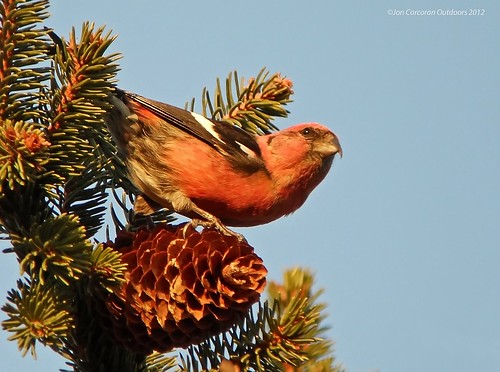White-winged Crossbill
(Loxia leucoptera)
Conservation • Description • Habitat • Ecology • Distribution • Taxonomy
|
|
||||||||||||||
Description |
White-winged Crossbill is a colorful, medium-sized finch. It occurs in the temperate and subpolar regions of the Northern Hemisphere. In Minnesota it is common to uncommon in the northeastern coniferous and mixed forests, occasional to rare in the remainder of the state. Migration is irruptive, with large numbers visiting the state one year and none the following year. It is found mostly in coniferous forests with spruce, tamarack, and eastern hemlock, sometimes in deciduous forests, and sometimes in towns. Adults feed mostly on spruce and tamarack seeds, but also on the seeds of other coniferous trees and deciduous trees, and occasionally on insects. Adults are 5⅞″ to 16¾″ (15 to 17 mm) in length and have a 10¼″ to 11″ (26 to 28 mm) wingspan. They have a stocky body, a large head, and a crossed bill. The breeding male has a pinkish-red head, neck, chest, and back. The underparts are pinkish-red, fading to white in the rear, with brown streaks. The tips of the bill are crossed over, an adaptation that helps when extracting seeds from a spruce seed cone. This is the feature that gives the genus its common name. The wings and tail are black. There are two bold white wing bars on each wing. This is the feature that gives both the American and the European subspecies their common names. The innermost flight feathers (tertials) have white tips. Females are greenish-yellow streaked with brown overall. Juveniles in their first plumage are heavily streaked overall. Subadult males are patchy red and yellow and are streaked overall. Immatures (juveniles and subadults) have bold white wing bars. |
Size |
Length: 5⅞″ to 16¾″ (15 to 17 mm) Wingspan: 10¼″ to 11″ (26 to 28 mm) |
Voice |
|
|
Similar Species |
Red Crossbill (Loxia curvirostra) is deeper red. There are no white wing bars. |
Habitat |
Coniferous forests with spruce, tamarack, and eastern hemlock, sometimes deciduous forests, and sometimes towns. |
Ecology |
Migration |
Irruptive, large numbers in some years, none in other years. |
Nesting |
White-winged Crossbills rarely nest in Minnesota. |
Food |
Mostly spruce and tamarack seeds, but also the seeds of other coniferous trees and deciduous trees, and occasionally insects. |
Distribution |
Occurrence |
Common to uncommon in the northeastern coniferous and mixed forests, occasional to rare in the remainder of the state. |
Maps |
The Minnesota Ornithologists’ Union All Seasons Species Occurrence Map |
Taxonomy |
|
Class |
Aves (birds) |
Order |
Passeriformes (perching birds) |
Family |
Fringillidae (finches, euphonias, and allies) |
Subfamily |
Carduelinae |
Genus |
Loxia (crossbills) |
Subordinate Taxa |
|
American White-winged Crossbill (Loxia leucoptera ssp. leucoptera) Eurasian White-winged Crossbill (Loxia leucoptera ssp. leucoptera) |
|
Synonyms |
|
|
|
Visitor Photos |
||
Share your photo of this bird. |
||
This button not working for you? |
||
Gregory Gilman |
||
New Visitor |
||
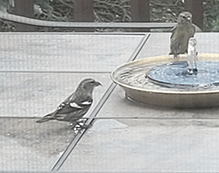 |
||
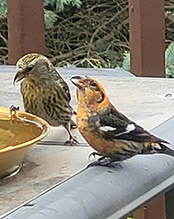 |
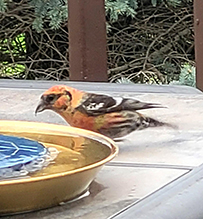 |
|
Dan W. Andree |
||
Male & Female White-winged Crossbills... Been in the area for a couple days and my guess is they will soon move on. Nice to see a bird that is often not seen in my area otherwise. I had never seen one in real life until these past couple days. I always thought by some photos I seen they were larger but they are smaller than what I thought. Remind me a little of Pine Grosbeaks but smaller etc. and different beak. Neat little birds. They were feeding on spruce tree cones. |
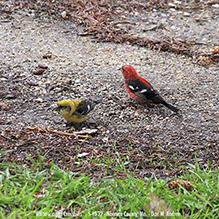 |
|
White-winged Crossbill... I still have them feeding on spruce tree cone seeds and getting nice imagery. This morning one came right underfoot and I had to point the camera directly down to film it. I also panned a little to show part of my foot. Neat little bird and memorable experience I gotten so close to them. Seems to be just 3 of them a red or mature male, a female and a juvenile male since it looks like it has a slight wash of red in areas. Glad I have those large spruce trees and they stop over to feed as they pass through. Only other bird that came under my feet and tripod was the American Redstart.… I filmed this male in 4k 5-10-22 in one of my spruce trees. He was stretching his wings and tail. |
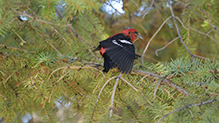 |
|
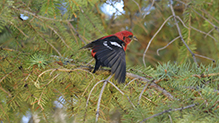 |
||
MinnesotaSeasons.com Photos |
||
|
||
|

Visitor Videos |
||
Share your video of this bird. |
||
This button not working for you? |
||
Dan W. Andree |
"White winged Crossbills" filmed by Dan W Andree |
About
noticed some small birds in my front yard last Spring 2022 that I hadn't seen before and come to know they were White-winged Crossbills. They were feeding on spruce tree cone seeds. They would return on and off for about 3 days. I had never seen this species of bird before. Found them interesting and unique little birds. Hope you enjoy this. |
Other Videos |
||
White-winged Crossbill (Loxia leucoptera) Video 2022-02-14 (1a) |
About
Feb 14, 2022 White-winged Crossbill (Loxia leucoptera) - digiscoped video - 14 February 2022 - Ella Sharp Park, Jackson City, Jackson County, Michigan |
How Nature Works: White-winged Crossbill Feeding Technique |
About
Apr 16, 2010 Take an up-close look at the remarkable physical adaptations White-winged Crossbills use to retrieve seeds hidden inside tightly closed spruce cones. Check out All About Birds for more information on White-winged Crossbills: https://www.allaboutbirds.org/guide/white-winged_crossbill/id |
White-winged Crossbills |
About
Feb 4, 2012 Some short video clips of male and female white-winged crossbills from the boreal forest of Maine. Crossbills can be a tough species to video since they spend most of their time high in the trees feeding on the seeds of conifer cones. © 2011 Garth McElroy. License at http://www.paya.com/videos/135205 |
White-winged Crossbills |
About
Feb 7, 2021 White-winged Crossbill ( Loxia leucoptera ) filmed 12-04-2020 at Forest Beach Migratory Preserve , Port Washington, Wisconsin. This was a eruption year for this northern finches. #WhitewingedCrossbill |
White-winged crossbills in Paradise | Kettle Moraine State Forest, Wisconsin |
About
Nov 24, 2020 White-winged crossbills are a rare Winter visitor in the Midwestern United States. But as is the case with many Winter Finches this year, they are showing up in places much further South than they are normally found. I was happy to be able to watch this cooperative flock of 30-40 of them devouring the seeds of Spruce Trees, especially since these are considered the rarer of the two Crossbill Species that show up in our region. Thankfully, it appears they have plenty of cones to last the Winter, but who knows... So what brings them here? In certain years when their food supply up in Canada is poor, they irrupt south in search for better cone crops, and them found them! Like Red Crossbills, White-winged crossbills utilize their oddly-shaped bill to pry open the scales of Spruce cones, which I think is pretty awesome and fascinating to watch. |

Visitor Sightings |
||
Report a sighting of this bird. |
||
This button not working for you? |
||
Gregory Gilman |
Location: NW Rochester, MN New Visitor |
 |
MinnesotaSeasons.com Sightings |
||
|

Created: 5/25/2022 Last Updated: © MinnesotaSeasons.com. All rights reserved. |

